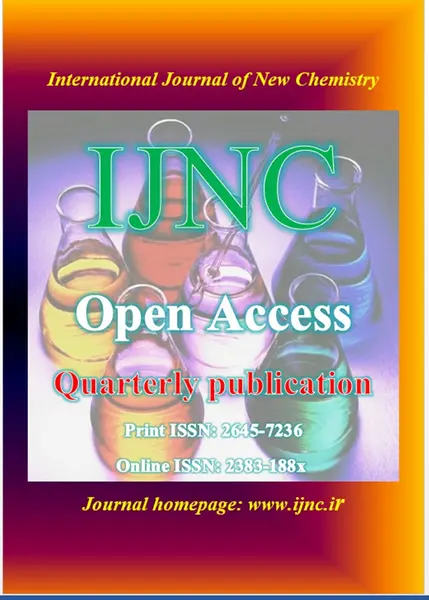-
investigation of the conversion process of verdoheme hydroxyl iron (ii) to biliverdin iron (ii): theoretical study
جزئیات بیشتر مقاله- تاریخ ارائه: 1400/11/12
- تاریخ انتشار در تی پی بین: 1400/11/12
- تعداد بازدید: 223
- تعداد پرسش و پاسخ ها: 0
- شماره تماس ژورنال: 09122976055
investigation of the conversion process of verdoheme hydroxyl iron (ii) to biliverdin iron (ii): theoretical study
heme oxygenase (ho) is an enzyme that breaks down heme and as a result iron is recycled in most organisms, including the human body. this enzyme produces bilirubin, divalent iron, and carbon monoxide. heme oxygenase was first described in the late 1960s [1-3]. study of the reaction of the peripheral substituents on the heme ring with verdohemes offers models that are not very well known. in this project, a computational study of destruction reaction of verdoheme iron (ii) was carried out and the role of lateral substitutionson its hydrolysis process was investigated.
theoretical calculations show that the rate of hydrolysis reaction is slower for complexes containing peripheral substitutions. on the other hand, hydrolysis of verdohemes non-environmental is a convenient parameter for energy. to better understand this process, theoretical calculations were performed using the dft method. calculations of the stability energy of the compounds showed that the higher the intermolecular interactions of hydrogen, the greater the stability of the compound. also, the highest stability energy is related to compound d, which has more intermolecular interactions from type of the hydrogen bonds.
حوزه های تحت پوشش ژورنال
مقالات جدیدترین رویدادها
-
استفاده از تحلیل اهمیت-عملکرد در ارائه الگوی مدیریت خلاقیت سازمانی و ارائه راهکار جهت بهبود
-
بررسی تاثیر ارزش وجوه نقد مازاد بر ساختار سرمایه شرکت های پذیرفته شده در بورس اوراق بهادار تهران
-
بررسی تأثیر سطح افشای ریسک بر قرارداد بدهی شرکت های پذیرفته شده در بورس اوراق بهادار تهران
-
بررسی تأثیر رتبه بندی اعتباری مبتنی بر مدل امتیاز بازار نوظهور بر نقد شوندگی سهام با تأکید بر خصوصی سازی شرکت ها
-
تأثیر آمیخته بازاریابی پوشاک ایرانی بر تصویر ذهنی مشتری پوشاک ایرانی (هاکوپیان)
-
بررسی تاثیر مسئولیت اجتماعی شرکت بر عملکرد با تاکید بر نقش میانجی مدیریت منابع انسانی سبز در صنعت هتل داری
-
مطالعه ویژگی ها قوس بحرانی و رخدادهای پس از انهدام قوس پایدار در مصالح دانه ای به کمک دستگاه توسعه یافته دریچه
-
اصول و معیارهای طراحی معماری سبز با تاکید بر تکنولوژی بام سبز
-
بررسی آزمایشگاهی تعیین فرسایش پذیری سوسپانسیون ها، جهت تزریق در سازه های هیدرولیکی
-
ارزیابی شش مولفه ای رکورد زلزله های نزدیک گسل
مقالات جدیدترین ژورنال ها
-
مدیریت و بررسی افسردگی دانش آموزان دختر مقطع متوسطه دوم در دروان کرونا در شهرستان دزفول
-
مدیریت و بررسی خرد سیاسی در اندیشه ی فردوسی در ادب ایران
-
واکاوی و مدیریت توصیفی قلمدان(جاکلیدی)ضریح در موزه آستان قدس رضوی
-
بررسی تاثیر خلاقیت، دانش و انگیزه کارکنان بر پیشنهادات نوآورانه کارکنان ( مورد مطالعه: هتل های 3 و 4 ستاره استان کرمان)
-
بررسی تاثیر کیفیت سیستم های اطلاعاتی بر تصمیم گیری موفق در شرکتهای تولیدی استان اصفهان (مورد مطالعه: مدیران شرکتهای تولیدی استان اصفهان)
-
مقایسه تمایزیافتگی خود در نوجوانان با ساختارخانوادگی تک والد (والد-مادر) و خانواده هسته ای
-
ارتقا هویت یابی سازمانی از طریق برندسازی کارفرمایی (مورد مطالعه: شرکت کیسون)
-
بررسی سیر تاریخی شناخت علمی ادیان و پیدایش علم ملل و نحل در تاریخ و تمدن اسلامی برای همزیستی مسالمت آمیز
-
ارزیابی مؤلفه های تأثیرگذار بر جذب مشتریان و تمایل آن ها به خرید با تأثیرپذیری از سطح قدرت اجتماعی برند
-
the study of dissolution boric acid in different temperature conditions, the dft method


سوال خود را در مورد این مقاله مطرح نمایید :